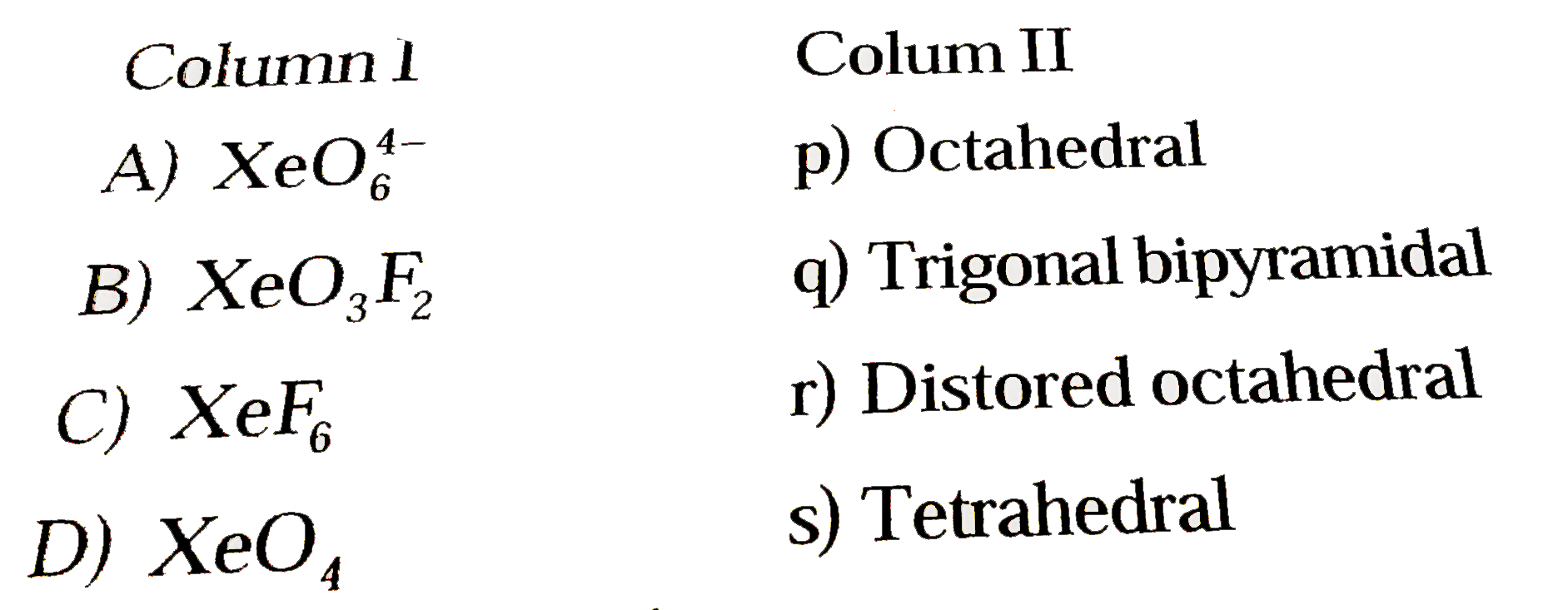Complete Solutions to LEVEL - V of chapter 18TH GROUP ELEMENTS of Class 12 book with complete answers and questions
| Class 12 | CHEMISTRY |
| Chapter | 18TH GROUP ELEMENTS |
| NARAYANA | LEVEL - V |
| Number Of Questions | 32 |
| Academic Year | 2023-24 |
Argon is used in arc welding because
View Solution`XeF_(2)` on hydrolysis (in the presence of alkali) yield :
View Solution`XeF_(6)` can acts as
View SolutionXenon tetrafluoride, `XeF_(4)` is:
View Solution`XeF_(4)` on partial hydrolysis produces
View SolutionIn `XeF_(4)` molecule, xenon undergoes
View Solution`XeF_(6)` on complete hydroloysis gives
View SolutionWhich of the following compound will not form during the hydrolysis of `XeF_(6)` ?
View SolutionThe nature of `pi` - bonds in `XeO_(3)` :
View Solution`XeO_(4)` contains :
View SolutionWhen `XeF_(4)` donates its fluoride to `SbF_(5)`, then the states of hybridization of central atoms of cationic part and anionic part of the product formed are :
View SolutionWhich of the following compound is formed when `XeF_(4)` react with water ?
View SolutionWhich of the following statement is wrong ?
View SolutionWhich one of the following reaction of xenon compounds is not Feasible?
View SolutionThe hydrolysis of `XeF_(6)` takes place in the following steps : `XeF_(6) rarr A rarr B rarr XeO_(3)`. Then the correct statement regarding A and B is :
View SolutionWhich of the following statement(s) is/are correct ?
View SolutionWhich of the following are correctly matched ?
View Solution`XeF_(6)` on hydrolysis gives
View SolutionWhite crystalline solid (A) reacts with `H_2` to form a highly associated liquid (B) and a monoatomic , colourless gas (C ). The liquid (B) is used for etching glass. Compound (A) undergoes hydrolysis slowly to form (C ), (B) and a diatomic gas (D ) whose IE is almost similar to that of (C ). (B) forms an addition compound with KF to form (E) which is electrolysed in the molten state to form a most reactive gas (F) which combines with (C ) in 2:1 ratio of produce (A).
Which of the following is correct for the white crystalline solid (A) ?
View SolutionWhite crystalline solid (A) reacts with `H_2` to form a highly associated liquid (B) and a monoatomic , colourless gas (C ). The liquid (B) is used for etching glass. Compound (A) undergoes hydrolysis slowly to form (C ), (B) and a diatomic gas (D ) whose IE is almost similar to that of (C ). (B) forms an addition compound with KF to form (E) which is electrolysed in the molten state to form a most reactive gas (F) which combines with (C ) in 2:1 ratio of produce (A).
According to Molecular Orbital Theory, which of the following is correct about the molecule (D) ?
View SolutionWhite crystalline solid (A) reacts with `H_2` to form a highly associated liquid (B) and a monoatomic , colourless gas (C ). The liquid (B) is used for etching glass. Compound (A) undergoes hydrolysis slowly to form (C ), (B) and a diatomic gas (D ) whose IE is almost similar to that of (C ). (B) forms an addition compound with KF to form (E) which is electrolysed in the molten state to form a most reactive gas (F) which combines with (C ) in 2:1 ratio of produce (A).
According to Molecular Orbital Theory, which of the following is correct about the molecule (D) ?
View SolutionAmong noble gases, Xe is quite reactive and form a number of fluorides and oxyfluorides. In these compounds the electrons, from 5p orbitals are excited to 5d orbitals. The predicted shapes of xenon fluorides are linear, square planar and distorted octahedron. The shapes of xeon oxyfluorides can be prodicted by VSEPR theory.
`XeF_(2)` on alkaline hydrolysis yields
View SolutionAmong noble gases, Xe is quite reactive and form a number of fluorides and oxyfluorides. In these compounds the electrons, from 5p orbitals are excited to 5d orbitals. The predicted shapes of xenon fluorides are linear, square planar and distorted octahedron. The shapes of xeon oxyfluorides can be prodicted by VSEPR theory.
View SolutionAmong noble gases, Xe is quite reactive and form a number of fluorides and oxyfluorides. In these compounds the electrons, from 5p orbitals are excited to 5d orbitals. The predicted shapes of xenon fluorides are linear, square planar and distorted octahedron. The shapes of xeon oxyfluorides can be prodicted by VSEPR theory.
View SolutionMatch the following :

View SolutionWhich one of the following does not exist ?
`(i) XeOF_(4) (ii) NeF_(2) (iii) XeF_(2) (iv) XeF_(6)`.
View SolutionAssertion : `XeF_(6)` cannot be stored in the dry glass bottles
Reason : `XeF_(6)` attacks the glass
View SolutionThe number of `(p pi- p pi)` bonds in `XeO_(4)` is :
View SolutionThe number of `pi` bonds in perxenate ion is :
View SolutionIn `XeOF_(2)` number of lone pairs on cetral atom is 'a' and number of bond pairs around central atom is 'b'. What is 'b/a' ?
View Solution`XeF_(6)` reacts with silica to form xenon compound X. The oxidation state of Xe in X is :
View SolutionIn argon, find the numer of electrons with spin value `+(1)/(2)`
View Solution
LEVEL - V questions and complete solutions for chapter 18TH GROUP ELEMENTS of NARAYANA CHEMISTRY (HINGLISH) of Class 12